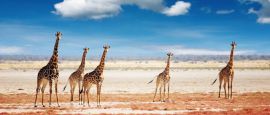Namibia History, Language and Culture
History of Namibia
From the rock paintings in the Twyfelfontein, anthropologists can tell us that Namibia's prehistory dates back more than 25,000 years when the first settlers moved to the area. Subsequently, a long and resilient lineage of various ethnic groups, from the San (Bushmen), Nama, Damara, Bantu, to the more recent Herero and Oorlams have been making this mostly barren land home.
Although Europeans had known about Namibia since 1486 when Portuguese Captain Diago Cão sailed along the South Atlantic coast, it wasn't until 1793 that Dutch settlers from Cape Colony (now South Africa) began to take an interest in Walvis Bay due to its natural deep-water harbour. Then came German settlers and they proclaimed Namibia, then known as South West Africa, as a German protectorate in 1884.
The German conquest wasn't plain sailing, however. From 1904 to 1907, the Herero people fought against German colonial troops but they lost dearly – historians believed that the war resulted in the death of 75% of the Herero population and 50% of the Nama population, making this genocide one of the darkest periods in Namibia's history.
In 1915, South Africa launched an attack and eventually captured South West Africa. Although South Africa became a sovereign independent state in 1934 and gained its full independence in 1961, Namibia did not as South Africa continued to tighten its grip on Namibia, leading to uprisings and the eventual formation of SWAPO (South West African Peoples Organisation). During this period, the UN General Assembly adopted a resolution that South West Africa be renamed Namibia in June 1968, following the wishes of its people.
SWAPO spent the next few decades battling to rid Namibia of the South African occupiers. In 1988, South Africa finally agreed to hand control of Namibia to the United Nations. A year later, the UN Transitional Assistance Group (UNTAG) supervised an election that resulted in SWAPO coming to power, after 106 years of colonialism and a protracted struggle for national liberation.
On 21 March 1990, Namibia attained its hard-won independence.
Did you know?
• The literacy rate in Namibia is about 92%, one of the highest in Africa.
• Namibia is one of the least populated countries in the world.
• The Namib Desert is believed to be 80 million years old, making it the oldest desert in the world.




 You know where
You know where